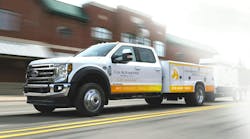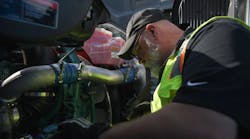I’ve spent a lot of time in truck shops, and I believe there is a 10- to 20-percent productivity improvement opportunity in most shops. In some operations, that number could be much higher.
What many fleets may not realize is that productivity improvements don’t necessarily have to come from making sweeping changes in the shop. They can be realized by making a series of small changes that together add up to big, impactful improvements.
At our recent Maintenance Managers Meeting, NationaLease members shared some of the “little things” they are doing to improve the efficiency of their shops.
Jim Ryan, vice president of operations, and Brian Roberts, director of maintenance, for Kris-Way Truck Leasing, a NationaLease member, undertook a lean analysis of their preventive maintenance (PM) service and found significant productivity opportunities. The amount of technician steps, lifting, getting up-and-down and shop clean-up time was alarming.
Through this lean process, they uncovered an opportunity to reduce technician labor by approximately 50 minutes per PM/oil change and that greatly reduced environmental concerns and workers compensation exposure.
The company modified an oil evacuation technology that allows its technicians to purge the old oil filter, take an oil sample, evacuate the sump to a waste tank or quick cart and refill the engine and new filter, all in 10 to 14 minutes. To further reduce the PM time, they added a fuel priming system which reduces more steps and clean-up time.
The technicians also like it. No one likes changing oil or cleaning the mess it makes.
Bill McAnally, vice president of maintenance for Miller NationaLease, told the group, “When a vehicle comes in for a PM, I don’t want to see it again until the next scheduled PM.” To make that goal a reality, the company uses a quality check form after a PM is completed. He said the results of those checks were “eye opening because we found tires on the same truck didn’t have the same inflation pressure.”
Quality Check Forms
McAnally invested in an air inflation tool that allows the technician to hook up air lines to the tires and read the tire pressure, looking for low pressure irregularities. Then the two regulators – one for the steer and one for the drive tires – inflate or deflate tires to equalize the pressure to the specified parameters.
The company now does alignment checks on every new truck because it was finding, he says, “an alarming amount of irregular tire wear early in a truck’s life because factory alignments were inaccurate.” Every new truck gets its alignment checked and adjusted as part of a pre-delivery inspection.
Time Savers
Kris-Way uses a PM “quick cart,” which contains all the things a technician needs to complete an oil change, so technicians can stay in the bay working. Other NationaLease members shared that they also use carts for general PM service, but in addition, have carts specifically for tires, brakes and air conditioning work.
During an Idea Session at the Maintenance Managers Meeting, members shared some of the things they are doing to improve productivity. These include:
- Using a “smoker” to find leaks for various diagnosis.
- Using a new tool to test the condition of belts.
- Evaluating parts storage locations and storing items like filters, exempt parts, tires, etc. close to the applicable shop bays.
- Reviewing, on a quarterly basis, each technician’s training map and offering online training courses. Also using a bonus incentive for the completed courses.
- Using simple signs and chains to keep drivers out of the shop so they are unable to distract technicians.
Technicians
All of these ideas to improve productivity are increasingly important as the industry continues to suffer from a technician shortage. The Department of Labor estimates there are 265,000 heavy duty diesel technicians, and that number is expected to grow by 12 percent in the next 10 years. Unfortunately, only 11,000 students are graduating from technical schools each year, so the gap between the number of technicians we need and the number available will continue to widen.
This means we need to make each technician as efficient as possible. That can be something as simple as reducing the number of steps a technician needs to complete a task, putting all the tools needed to complete a job in one place and eliminating distractions in the shop.
It also means ensuring your technicians are properly trained. Training needs to be made easier and more flexible for technicians. Unfortunately, there is no one program that will handle all of your training needs. You need a diverse curriculum utilizing OEM classroom training, training from local parts suppliers and outside companies, web-based training, home study and in-shop training.
Keep an eye out for, and institute, ideas that will contribute small changes, big improvements and a more efficient, profitable maintenance shop.
Joe Puff is vice president of truck technology and maintenance for NationaLease (www.nationalease.com). One of the largest full-service truck leasing organizations in North America, it has more than 700 service locations throughout the U.S. and Canada.


